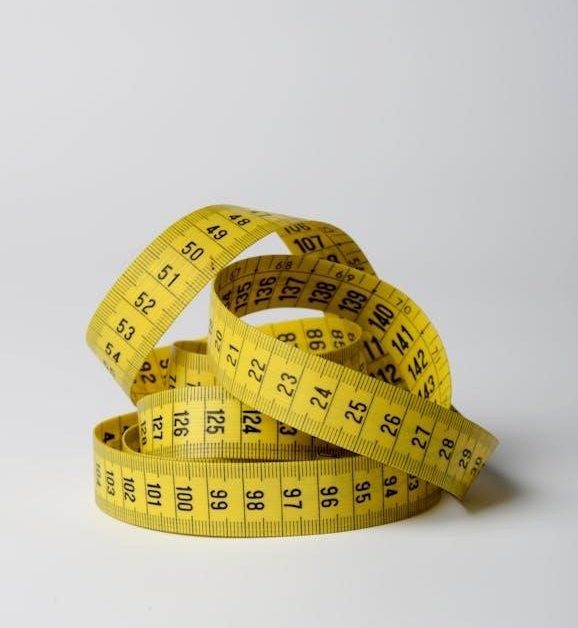Converting mixed numbers to improper fractions is a fundamental math skill essential for computations. This guide provides a clear process and resources, including PDF worksheets, to master the conversion.
What Are Mixed Numbers?
A mixed number is a combination of a whole number and a proper fraction. It represents a value greater than 1 but less than the next whole number. For example, in the mixed number 2 5/8, the whole number is 2, and the fractional part is 5/8. Mixed numbers are commonly used in everyday measurements, such as cooking or construction, where quantities are easily expressed as a whole with an additional fraction. They provide a clear and intuitive way to represent values that are not whole numbers. Understanding mixed numbers is essential for various mathematical operations, including conversion to improper fractions, which simplifies calculations like addition and subtraction.
What Are Improper Fractions?
An improper fraction is a type of fraction where the absolute value of the numerator is greater than the denominator. For example, in the fraction 7/4, the numerator (7) is larger than the denominator (4). Improper fractions represent values greater than 1 and are often used in mathematical calculations because they simplify operations like addition and subtraction; They can also be easily converted back to mixed numbers if needed. Understanding improper fractions is crucial for advanced math concepts, such as algebra and geometry. Worksheets and online resources are available to practice converting mixed numbers to improper fractions, making it easier to master this essential skill. Improper fractions are a fundamental part of fraction operations and real-world applications.
Why Convert Mixed Numbers to Improper Fractions?
Converting mixed numbers to improper fractions simplifies mathematical operations, especially addition, subtraction, and comparison. Improper fractions have a consistent format, making computations more straightforward. For example, operations involving mixed numbers often require separating the whole number and fraction, which can be error-prone; Improper fractions eliminate this step, reducing complexity. Additionally, improper fractions are essential in real-world applications like engineering, cooking, and STEM fields, where precise calculations are critical. Worksheets and practice exercises, such as those in PDF format, help students master this conversion, ensuring accuracy and confidence in their math skills. This skill is foundational for advanced fraction operations and problem-solving.
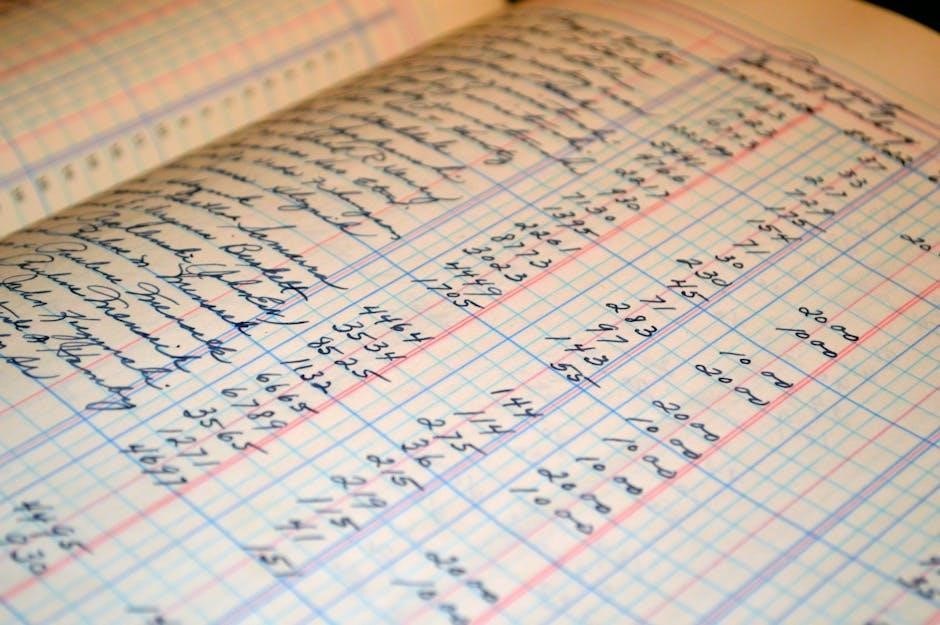
Step-by-Step Guide to Converting Mixed Numbers to Improper Fractions
Convert mixed numbers to improper fractions by multiplying the whole number by the denominator, adding the numerator, and placing the sum over the original denominator.
Understanding the Basic Concept
Converting mixed numbers to improper fractions involves understanding that a mixed number combines a whole number and a fraction. For example, in 3 1/2, 3 is the whole number, and 1/2 is the fraction. To convert this to an improper fraction, multiply the whole number by the denominator, then add the numerator. This process ensures the new numerator represents the total value of the mixed number. Using PDF worksheets, students can practice this method, starting with simple examples and progressing to more complex problems. These exercises help build a strong foundation in fraction operations, making it easier to perform calculations like addition and subtraction. Regular practice with worksheets also helps identify common mistakes, such as forgetting to multiply or add correctly.
Step 1: Identify the Whole Number and Fraction
The first step in converting a mixed number to an improper fraction is to identify the whole number and the fractional part. For example, in the mixed number 3 1/2, 3 is the whole number, and 1/2 is the fraction. This step is crucial because it sets the foundation for the multiplication and addition that follow. By breaking down the mixed number into its components, students can better understand how the whole number and fraction relate to each other. Using PDF worksheets, learners can practice this identification process with various examples, ensuring they grasp the concept before moving on to the next steps. This clear separation helps prevent confusion and errors in later calculations.
Step 2: Multiply the Whole Number by the Denominator
After identifying the whole number and the fraction, the next step is to multiply the whole number by the denominator of the fractional part. For instance, in the mixed number 3 1/2, multiply the whole number 3 by the denominator 2, resulting in 6. This multiplication converts the whole number into a fraction with the same denominator as the fractional part. It is essential to ensure the multiplication is accurate to avoid errors in the subsequent steps. Using PDF worksheets, students can practice this step with various mixed numbers, reinforcing their understanding of how whole numbers and fractions interact during conversion. This step lays the groundwork for adding the numerator in the next phase of the process.
Step 3: Add the Numerator to the Product
Once you have the product from Step 2, the next step is to add the numerator of the original mixed number to this product. For example, in the mixed number 3 1/2, after multiplying the whole number 3 by the denominator 2 to get 6, you then add the numerator 1 to 6, resulting in 7. This sum becomes the new numerator of the improper fraction, while the denominator remains the same. It is crucial to perform this addition accurately to ensure the improper fraction is correct. Practicing this step with PDF worksheets helps students master the process and understand how mixed numbers transform into improper fractions seamlessly.
Step 4: Write the Result as an Improper Fraction
After adding the numerator to the product in Step 3, the final step is to write the result as an improper fraction. The sum obtained becomes the new numerator, while the denominator remains unchanged. For instance, if the mixed number is 3 1/2, and the sum is 7, the improper fraction is written as 7/2. It is essential to ensure the fraction is not simplified further unless required. This step completes the conversion process, providing a clear and accurate improper fraction. Practicing with PDF worksheets helps reinforce this method, ensuring students can confidently convert mixed numbers to improper fractions.
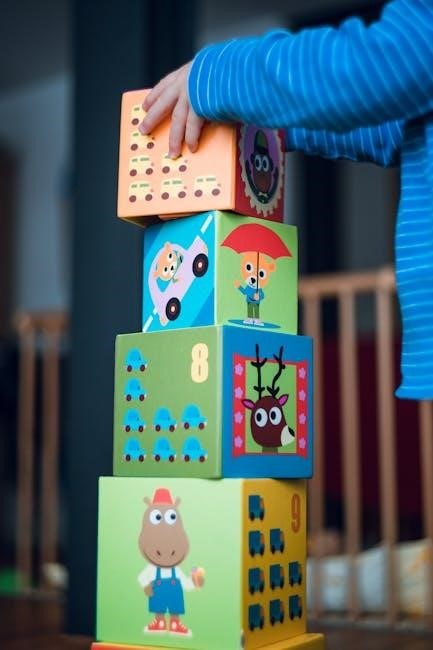
Practice Worksheets for Converting Mixed Numbers to Improper Fractions
Downloadable PDF worksheets offer a variety of exercises to practice converting mixed numbers to improper fractions. These resources are designed to build confidence and fluency in fraction conversion skills.
Features of a Good Worksheet
A good worksheet for converting mixed numbers to improper fractions should include clear instructions, examples, and a variety of problems. It should cater to different skill levels, offering both simple and challenging exercises. Visual aids, such as diagrams or models, can help students understand the concept better. The worksheet should also provide space for calculations and answers. Additionally, it should include an answer key for self-assessment or teacher review. A well-designed worksheet will be easy to read, with proper formatting and clear fonts. Many worksheets are available in PDF format, making them easy to download and print. They should also be free of errors and aligned with curriculum standards to ensure effective learning.
Benefits of Using Worksheets
Using worksheets to practice converting mixed numbers to improper fractions offers numerous benefits. They provide individualized practice, allowing students to work at their own pace and reinforce their understanding of the concept. Worksheets help identify areas where students may need additional support. They also serve as valuable tools for self-assessment, as many include answer keys for verification. Regular use of worksheets improves problem-solving skills and builds confidence in handling fractions. Additionally, worksheets are versatile, suitable for both classroom use and homeschooling. They often include a variety of problems, catering to different learning styles and levels of difficulty. Overall, worksheets are an effective and efficient way to master the conversion process, ensuring a strong foundation in fraction operations.
How to Choose the Right Worksheet for Your Needs
Selecting the appropriate worksheet for converting mixed numbers to improper fractions involves considering the student’s grade level and skill level. Worksheets designed for 4th or 5th graders are ideal for introducing the concept, while more advanced sheets cater to older students. Look for worksheets that align with the desired difficulty level, such as easy, medium, or hard problems. Some worksheets include visual models, which are beneficial for visual learners, while others focus on abstract calculations. Ensure the worksheet includes answer keys for self-assessment and consider interactive tools for additional practice. PDF formats are convenient for printing and sharing. By matching the worksheet to the learner’s needs, the practice becomes more effective and engaging, fostering a deeper understanding of fraction conversion.
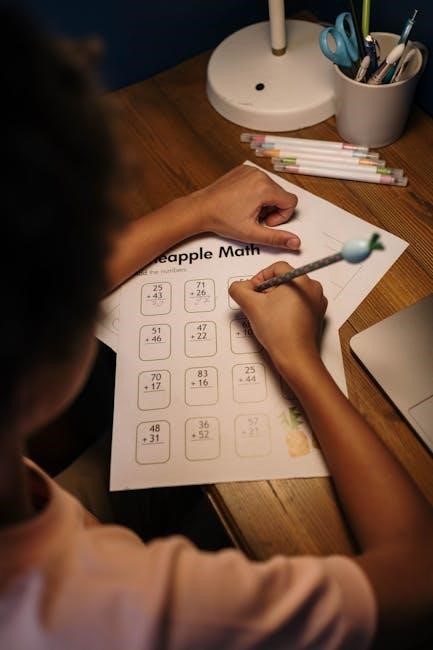
Downloading and Using the PDF Worksheet
Accessing the PDF worksheet is straightforward. Simply click the download link, save the file, and print it for practice. This format ensures easy access and convenience.
How to Download the Worksheet
Downloading the worksheet is a quick and easy process. Locate the download button on the webpage, typically labeled as “Download PDF” or “Printable Worksheet.” Click on this button to initiate the download. The file will be saved in PDF format, ensuring compatibility with most devices. The size of the file is usually small, around 26,389 bytes, making it a fast download. Once downloaded, you can easily print the worksheet for practice. This convenient format allows students to practice converting mixed numbers to improper fractions offline. The worksheet is suitable for students in grade 5 and above, providing a structured approach to mastering this essential math skill. By following these simple steps, you can access the worksheet and begin practicing immediately.
Printing the Worksheet
Printing the worksheet is straightforward and ensures you have a physical copy for practice. Once downloaded, open the PDF file using a PDF reader. Select the print option from the file menu or use the keyboard shortcut Ctrl+P. Choose your preferred printer and adjust settings like page orientation to ensure proper alignment. The worksheet is designed to fit standard paper sizes, making it easy to print. Ensure your printer has enough ink and paper before starting. The clear layout and large text make it ideal for students to work on. Printing the worksheet allows for a tactile learning experience, helping students focus on converting mixed numbers to improper fractions effectively. This step is crucial for offline practice and reinforces the concepts learned digitally.
Using the Worksheet Effectively
To use the worksheet effectively, start by reviewing the examples provided. Begin with simpler problems to build confidence and understanding. Use a pencil to write your answers, allowing for easy corrections. For each mixed number, apply the conversion formula: multiply the whole number by the denominator, add the numerator, and place the result over the original denominator. Check your work by converting the improper fraction back to a mixed number. For visual learners, draw diagrams to represent the fractions. After completing the worksheet, review any incorrect answers to identify common mistakes. Regular practice with these exercises will enhance your proficiency in converting mixed numbers to improper fractions. Consistent use of the worksheet ensures mastery of this essential math skill.

Tips for Mastering the Conversion Process
Understand the relationship between mixed numbers and improper fractions. Practice regularly using worksheets. Use visual aids to simplify complex problems; Break down each step for clarity and consistency. Check your work by converting back to mixed numbers to ensure accuracy. Regular practice and review are key to mastering this skill.
Understanding the Relationship Between Mixed Numbers and Improper Fractions
Mixed numbers and improper fractions are two ways to represent the same value. A mixed number consists of a whole number and a proper fraction, while an improper fraction has a numerator greater than its denominator. The key to conversion is understanding that the whole number in a mixed number can be broken down into fractions with the same denominator as the fractional part. For example, in the mixed number 3 1/2, the whole number 3 can be expressed as 6/2, making the improper fraction 7/2. This relationship simplifies arithmetic operations, as improper fractions are easier to compute with. Practicing with worksheets helps solidify this concept and ensures accuracy in conversions.
Practicing Regularly
Regular practice is essential for mastering the conversion of mixed numbers to improper fractions. Using PDF worksheets provides a structured and convenient way to reinforce this skill. These worksheets, often designed for grade 5 and above, offer a variety of problems that cater to different learning paces. By practicing consistently, students can build confidence and fluency in converting mixed numbers to improper fractions. The repetition helps solidify the understanding of the relationship between whole numbers and fractions, making arithmetic operations more intuitive. Over time, regular drills enable students to apply this skill effortlessly in real-world problems and more complex mathematical scenarios.
Using Visual Aids
Visual aids are a powerful tool for understanding and mastering the conversion of mixed numbers to improper fractions. Using diagrams, circles, or fraction bars helps students visualize the relationship between whole numbers and fractions. These tools make it easier to break down mixed numbers into their components, such as the whole number and the fractional part. For example, a circle divided into sections can illustrate how a whole number combines with a fraction to form an improper fraction. Many PDF worksheets include visual models, especially for younger learners, to simplify the process. Interactive tools and videos also provide step-by-step solutions, reinforcing the concept and making practice more engaging. Visual aids are particularly effective for students who learn better through seeing rather than just reading or listening.
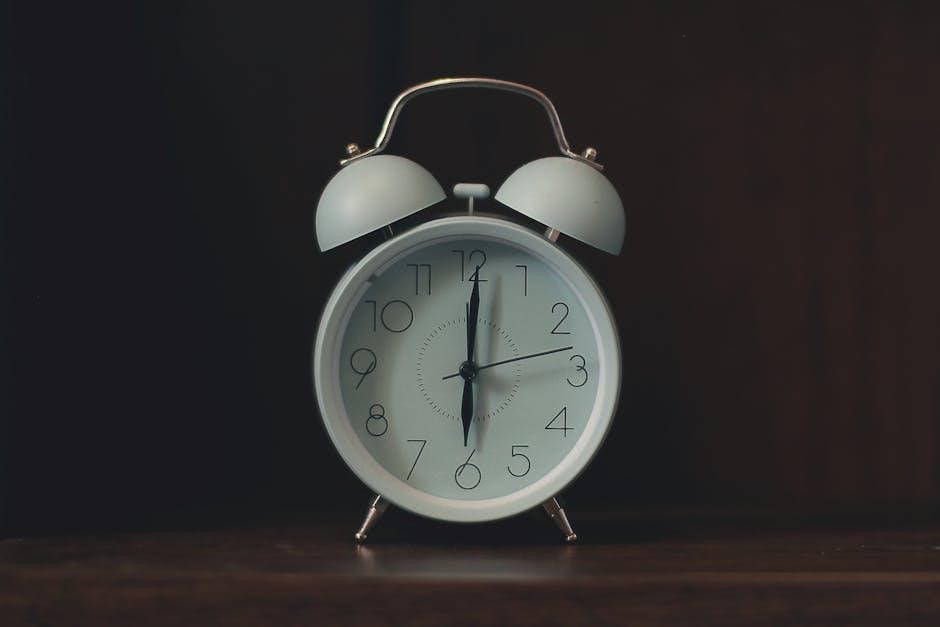
Common Mistakes to Avoid
Common mistakes include forgetting to multiply the whole number by the denominator, adding instead of multiplying, and not simplifying the fraction. Awareness helps improve accuracy.
Forgetting to Multiply the Whole Number by the Denominator
One of the most common mistakes when converting mixed numbers to improper fractions is forgetting to multiply the whole number by the denominator. This step is crucial because it determines the value of the improper fraction. For example, in the mixed number 3 1/2, the whole number (3) must be multiplied by the denominator (2) to get 6. Adding the numerator (1) gives 7, resulting in the improper fraction 7/2. If this step is skipped, the result is incorrect. To avoid this, always remember to multiply the whole number by the denominator before adding the numerator. Practicing with PDF worksheets can help reinforce this process and reduce errors over time.
Adding Instead of Multiplying
Another common error when converting mixed numbers to improper fractions is adding the whole number and the numerator instead of multiplying the whole number by the denominator. For instance, when converting 3 1/2, some students incorrectly add 3 and 1 to get 4, resulting in 4/2 instead of the correct 7/2. This mistake occurs because the process requires multiplying the whole number by the denominator before adding the numerator. To avoid this, always follow the step-by-step method: multiply the whole number by the denominator, then add the numerator. Using PDF worksheets to practice this conversion regularly can help students develop the correct habit and reduce errors. Double-checking work can also prevent this mistake and ensure accuracy.
Not Simplifying the Fraction
One common mistake when converting mixed numbers to improper fractions is forgetting to simplify the resulting fraction. For example, converting 2 4/6 to an improper fraction yields 16/6, but many students stop there. However, 16/6 can be simplified to 8/3 by dividing both the numerator and the denominator by their greatest common divisor, which is 2. Failing to simplify can lead to incorrect answers in further calculations. To avoid this, always check if the numerator and denominator have a common factor and reduce the fraction if possible. Using PDF worksheets with answers can help students identify and correct this mistake. Regular practice and double-checking work are key to developing this habit and ensuring accuracy in conversions.

Real-World Applications of Improper Fractions
Improper fractions are essential in real-world scenarios like cooking, construction, and engineering. They simplify measurements and calculations, ensuring accuracy in recipes and project designs. PDF worksheets help students grasp these practical uses, making math relevant and functional for everyday life.
Everyday Uses of Improper Fractions
Improper fractions are widely used in daily life, particularly in cooking, where recipes often require precise measurements. For instance, adjusting ingredient quantities or scaling recipes up or down relies heavily on improper fractions. They are also essential in construction and engineering for material measurements, ensuring accuracy in projects. Additionally, improper fractions simplify complex calculations in budgeting, time management, and even sports statistics. Their practical applications make them a versatile tool for problem-solving. Using PDF worksheets, students can practice converting mixed numbers to improper fractions, enhancing their ability to apply these skills in real-world scenarios. This practice builds a strong foundation for understanding how fractions are used beyond the classroom.
Importance in STEM Fields
Improper fractions play a crucial role in STEM fields, where precise calculations are essential. In engineering, they are used for designing structures and calculating materials. Physicists rely on improper fractions to express ratios and proportions in complex formulas. Computer scientists use them in algorithms for scaling and data processing. Improper fractions are also vital in chemistry for mixing solutions and calculating molecular ratios. Mastery of improper fractions, through practice with worksheets, is foundational for success in these fields. Their ability to represent values greater than one simplifies computations, making them indispensable in scientific and technical applications. Proficiency in converting mixed numbers to improper fractions is a key skill for STEM professionals, enabling accurate and efficient problem-solving.
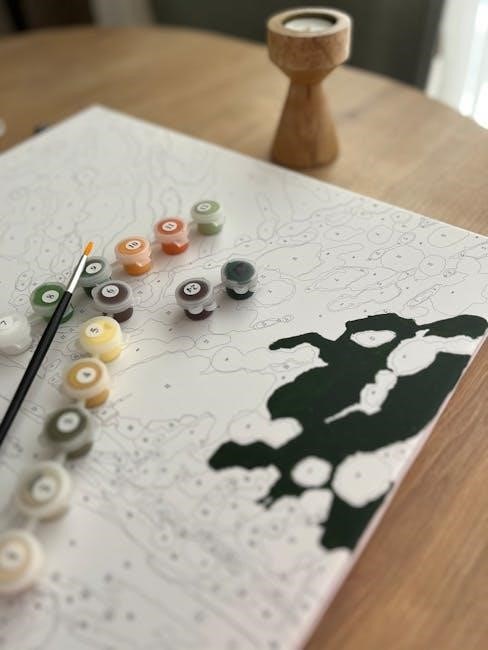
Additional Resources for Learning
Enhance learning with online tutorials, interactive tools, and additional practice worksheets. These resources provide comprehensive support for mastering conversions, ensuring a solid understanding of the process.

Online Tutorials and Videos
Online tutorials and videos provide step-by-step guidance for converting mixed numbers to improper fractions. Websites like Math Salamanders offer video walkthroughs and interactive tools to enhance understanding. These resources often include examples, practice problems, and detailed explanations. Videos, such as those by West Explains Best, demonstrate conversions in real-time, making complex concepts easier to grasp. Additionally, many platforms feature quizzes and interactive exercises to test skills and track progress; These digital resources cater to different learning styles, ensuring that students can master the process at their own pace. They are particularly useful for visual learners and those who benefit from hands-on practice. Utilizing these tools can significantly improve proficiency in converting mixed numbers to improper fractions.
Interactive Tools and Games
Interactive tools and games make learning to convert mixed numbers to improper fractions engaging and fun. Websites offer fraction calculators, quizzes, and riddles that challenge students to apply their skills. These tools provide immediate feedback, helping students identify mistakes and improve quickly. Games like fraction riddles require solving clues to find the correct fraction, enhancing problem-solving skills. Interactive models, such as circle diagrams, visually demonstrate conversions, aiding visual learners. Many platforms also offer progress tracking, allowing students to see their improvement over time. These resources are ideal for students who enjoy hands-on learning and want to practice in a more dynamic way. They complement traditional worksheets by adding an element of interactivity and enjoyment to the learning process.
Further Practice Worksheets
Further practice worksheets are essential for reinforcing the skill of converting mixed numbers to improper fractions. These worksheets, available in PDF format, offer a variety of problems to suit different learning needs. They include exercises for converting mixed numbers to improper fractions and vice versa, ensuring a comprehensive understanding. Many worksheets are graded by difficulty, starting with simple problems and progressing to more complex ones. Visual aids, such as circle diagrams, are often included to help students visualize the conversion process. Additionally, some worksheets feature word problems, applying the concept to real-life scenarios. Answer keys are usually provided, allowing students to check their work and learn from mistakes. Regular practice with these worksheets helps build confidence and mastery of the topic.
Mastering the conversion of mixed numbers to improper fractions is achievable with consistent practice. Utilize PDF worksheets and online resources to reinforce your understanding and skills effectively.
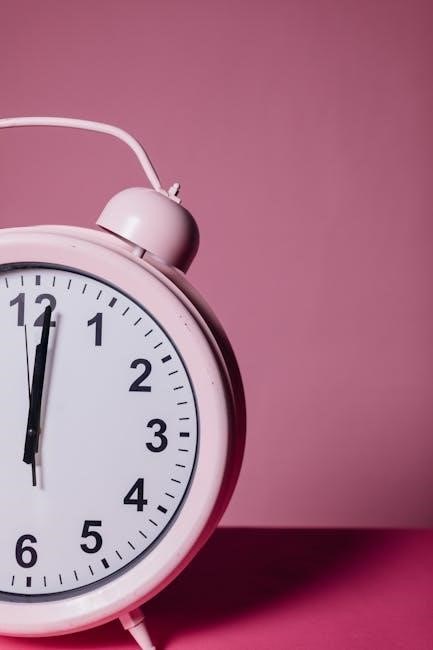
Converting mixed numbers to improper fractions involves multiplying the whole number by the denominator, adding the numerator, and placing the result over the original denominator. This process simplifies calculations and comparisons. Using PDF worksheets provides structured practice, helping students grasp the concept through repetition and visualization. These resources are particularly beneficial for grade 4 and 5 students, offering both visual and abstract exercises. Regular practice ensures mastery, while additional tools like calculators and video tutorials offer further support. Understanding this conversion enhances problem-solving skills in real-world applications and STEM fields, making it a foundational math skill worth thorough practice and review.
Encouragement to Continue Practicing
Consistent practice is key to mastering the conversion of mixed numbers to improper fractions. With each worksheet completed, you’ll grow more confident and skilled in handling these mathematical operations. The availability of PDF worksheets makes it easy to practice anytime, anywhere, ensuring you can reinforce your understanding at your own pace. Celebrate small victories, like correctly converting a challenging mixed number, to stay motivated. Remember, every problem solved brings you closer to excelling in fractions and their real-world applications. Keep up the great work, and soon converting mixed numbers will become second nature!
